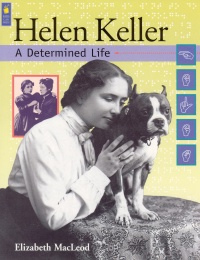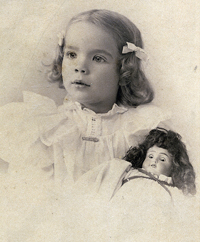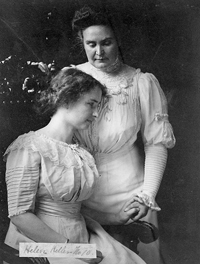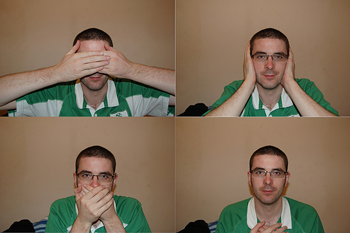
Source: Helen Keller Book Cover, divadogthemovie, Flickr
To make complex inferences, you need to examine not only stage directions and dialogue but also characters and plots for clues. Sometimes these clues may not be easy to connect, as you will see in the next play.
In The Miracle Worker, a play based on the life of Helen Keller, we see Keller as a child and learn about the influence her teacher, Anne Sullivan, had on her. Keller was left completely blind and deaf by illness when she was an infant in 1880, and her family considered her impossible to teach until Sullivan began working with her.
Read the following passage from act 1 of the play and pay attention to the characters to identify character traits that are unique to each. In this scene, Keller (Helen) is playing with her doll in the family’s living room while her mother Kate, and her father, Captain Keller, observe.
But HELEN has suddenly come upon the cradle [where her baby sister Mildred lies], and unhesitatingly overturns it; the swaddled baby tumbles out, and CAPTAIN KELLER barely manages to dive and catch it in time.)
KELLER
Helen!
(All are in commotion, the baby screams, but HELEN unperturbed is laying her doll in its place. KATE on her knees pulls her hands off the cradle, wringing them. HELEN is bewildered.)
KATE
Helen, Helen, you’re not to do such things, how can I make you understand—
KELLER
(Hoarsely) Katie.
KATE
How can I get it into your head, my darling, my poor—
KELLER
Katie, some way of teaching her an iota of discipline has to be—
KATE
(Flaring) How can you discipline an afflicted child? Is it her fault?
(HELEN’S fingers have fluttered to her MOTHER’S distraught lips, vainly trying to comprehend their movements.)

Source: Top His girl with doll 1, Marion Doss, Flickr
For the next exercise, think about what we can infer about Helen from the passage. Be sure to look at both the dialogue and the stage directions.
For example, to find text that indicates Helen is not upset, you could reread the passage and notice that, in the stage directions, “HELEN unperturbed is laying her doll in its place.” This is the text evidence that helps us understand that Helen is not disturbed with the activity. So, we can match “not upset” with this supporting evidence. Using this example, see if you can complete the rest of the chart in the exercise below. Read the supporting text evidence in the left column. Then, drag and drop the corresponding emotion or character trait beside the supporting evidence.


Source: Helen Keller27, Wikimedia
 If you examine these traits closely, some of them appear to be contradictory. For example, Helen is described as being both “unperturbed” as well as “bewildered” and frustrated—not upset and upset at the same time! From this seeming contradiction of emotions, you can make a complex inference about Helen’s character. Thinking about all of these traits, write a response in your notes about the complex inference you could make. Use as many details from the text as possible. When you’re finished, check your understanding to see a possible response.
If you examine these traits closely, some of them appear to be contradictory. For example, Helen is described as being both “unperturbed” as well as “bewildered” and frustrated—not upset and upset at the same time! From this seeming contradiction of emotions, you can make a complex inference about Helen’s character. Thinking about all of these traits, write a response in your notes about the complex inference you could make. Use as many details from the text as possible. When you’re finished, check your understanding to see a possible response.
Helen seems to be an intelligent person because she knows that her baby doll, like a real baby, should go into the cradle. She is determined to put the doll in the cradle, even if her baby sister is already in it. Because she cannot see, hear, or speak, Helen is unable to express what she wants, feels, or knows in a way that her family will understand. She wants terribly to understand her family, too, but doesn’t know how.
 Now, based on the scene, make complex inferences about how the family views Helen’s future. Copy and paste the chart into your notes and write your answers there. When you’re finished, check your understanding to see some possible responses.
Now, based on the scene, make complex inferences about how the family views Helen’s future. Copy and paste the chart into your notes and write your answers there. When you’re finished, check your understanding to see some possible responses.| Character | What character may believe about Helen’s future | Evidence from text |
|---|---|---|
| Kate | ||
| Captain Keller | ||
| Helen |
| Character | What character may believe about Helen’s future | Evidence from text |
|---|---|---|
| Kate | Helen cannot change her unpredictable behaviors because of her physical problems and should be pitied. Kate does not see much hope and doesn’t know how to deal with Helen. | KATE on her knees pulls her hands off the cradle, wringing them. . . . KATE: How can you discipline an afflicted child? Is it her fault? |
| Captain Keller | Captain Keller thinks Helen needs to be disciplined. It seems as though he has lost patience with Helen. | KELLER: Katie, some way of teaching her an iota of discipline has to be— |
| Helen | Helen is in complete isolation. She cannot make herself heard. She seems to crave connection with others but is trapped by her disability. She probably has no idea what to expect in the future because she has to focus so hard on the present. | HELEN’S fingers have fluttered to her MOTHER’S distraught lips, vainly trying to comprehend their movements. |

Source: Day 77 – monkeys, red_tzar, Flickr
Good work! You have used text evidence AND gone beyond the literal words to make inferences and predictions about plot and characterization.
Finally, close your eyes and cover your ears. Try to sit like that for one minute.
 How long did one minute feel to you? How do you think you would react if you were in Helen’s situation? Write your thoughts in your notes. No sample response is provided since responses will vary.
How long did one minute feel to you? How do you think you would react if you were in Helen’s situation? Write your thoughts in your notes. No sample response is provided since responses will vary. Thankfully, Helen Keller discovered with the help of her teacher, Anne Sullivan, that she could read, write, and learn. She even successfully attended college. With the close reading skills you are learning, there is no telling what you, too, may discover and accomplish.